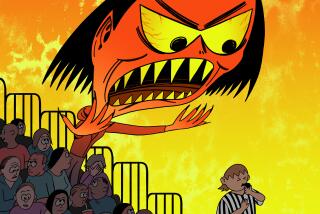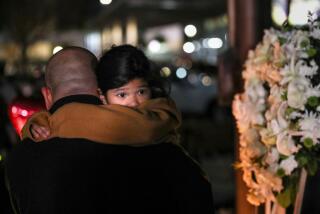Bully for Them
- Share via
They lurk around the boys’ room, alleys, the far end of the field. They tell you they don’t like your shirt, your shoes, your looks. They hit you up for your lunch money, or just plain hit you.
They’re bullies, found in every country, class and culture. Almost no one--especially not a boy--passes through elementary and middle school without at least one run-in with this nefarious archetype.
How parents and teachers help kids handle such harassment may mean the difference between a kid emerging unscathed and one who becomes bully bait. The traditional advice doesn’t work, say experts, who have new notions about how to give kids the tools they need to handle conflict and not get hurt in the process.
Parents should not dismiss the behavior as boys-will-be-boys, says Christine Honeyman, educational consultant and counselor for Irvine Unified School District. “The effects can be lifelong, and the bullying always escalates once the bully finds an outlet.”
“The generic response, to ignore the bully and he will go away, isn’t true,” says Jonathan Bloomberg, medical director of behavioral health services for Rockford Memorial Hospital in Rockford, Ill. “Ignoring only signals fear.”
Another common response is to tell the bully to pick on someone his own size. “That may play well in the adult world,” says Dr. Eugene Beresin, director of child and adolescent psychiatry at Harvard Medical School, “but in the child’s world it’s a good way to get pummeled.”
Finally, telling the teacher, while often necessary, may really do the kid in. “Teaching our kids to tell the teacher is contrary to the culture of childhood. It’s the equivalent of hiding behind your mother’s skirts,” Beresin says.
So what’s a parent to do?
First, discuss bullying behavior with your child before it becomes an issue. Most bullying starts in the early grades--even as early as first grade now with the influences of Ninja Turtles and Power Rangers, says Bloomberg, the father of a 6-year-old boy.
The behavior crystallizes in fifth grade then intensifies through high school. While more common among boys, girls bully too, only their tactics are less physical, usually involving rumors, humiliation and exclusion. But regardless of whether the abuse is physical or verbal, kids should know they shouldn’t tolerate the behavior and that they have options.
*
While responses are highly situational, most experts agree the first response should be to walk away. The trick is to walk away with confidence, says Bloomberg, who suggests perhaps saying something like, “Leave me alone, “ before exiting. “Usually the bully is all smoke, so that approach disarms the bully who is looking for a coward.”
If the bully persists, try a clever comeback, suggests Linda Rader, principal at Centralia Elementary School in Anaheim, who coaches the picked on to do the unexpected. “An unanticipated verbal response will defuse the bully. He won’t know how to respond.” Be careful, however, that the retort is neutral and not meant to provoke.
Honeyman agrees. Rather than get defensive--”What do you mean you don’t like my shirt?”--try reverse psychology. Agree with him. “Maybe this is an ugly shirt. I never thought of that.” Whatever you do, don’t let on that the bully’s getting to you.
Because victims are often introverted, Honeyman likes to help them find their voices. She coaches them to yell “stop it.” Often that response alone is unexpected enough to send the bully in search of meeker prey.
While most experts like the notion of giving children an arsenal of comebacks, be careful not to coach a child to fire a stock phrase that may not fit the context. “You could wind up making the kid look even more goofy,” Beresin says.
*
As important as teaching children how to defuse an aggressor is helping them know when to go for help. Teaching children how to tell, whom to tell and when to tell is a delicate art. Many kids are reluctant to tell, not only because they’re ashamed, but also because they’re afraid of retaliation.
Dr. Leonard Eron, professor of psychiatry at the Institute for Social Research at the University of Michigan, who’s studied bullying behavior for 30 years, believes kids should always tell. In general, his advice to victims is: Walk away if you can. Try not to take notice. Don’t appear to be upset. Don’t argue back, but hold your ground. Don’t stick around. Tell.
Beresin and Bloomberg like to see kids rebuff the bully on their own if possible. Before running to authorities, Beresin suggests kids round up a few friends as allies. “A teacher is a good backup, but the most powerful source of support will come from peers, or older siblings or friends. Bullies care a lot more what other kids think than what teachers think.”
All experts agree, however, that a child should be taught to tell immediately if there’s any threat of physical danger, especially a weapon. “That changes everything,” Honeyman says. “You don’t chat or come up with clever rejoinders. You comply, as long as you don’t get into his car or go with him anywhere. Get safe, even if that means screaming, running or pounding on a door. Then tell.”
In less extreme circumstances, kids should also be encouraged to tell their parents--but parents need to exercise restraint. While their first instinct may be to take matters into their own hands, the resounding advice is don’t. Calling the bully’s parents, for example, will probably only make matters worse.
“Usually bullies are part of a parallel process,” Beresin says. “The parents pick on the bully, so he picks on someone else. Calling the parents just sets this dynamic in motion.” Also, having parents rush to the rescue makes a child look more vulnerable.
“Kids don’t want to see parents jump into action, but they want to know a parent is hearing their concern and can offer insight and advice,” Bloomberg says.
Harder for some parents is to look at why their kid is always getting picked on. “Bullies pick on kids who send the message that they are vulnerable and weak and don’t feel good about themselves,” Beresin says.
Honeyman calls these kids provocative victims. “These kids whine, irritate others and just make other kids want to hit them. Parents need to be aware if that describes their kid and redirect behaviors that put them at risk.”
A good way to get perennial victims out of harm’s way is to help them get good at something, especially something physical, Beresin says. Unfortunately, looks and physical or social prowess still count heavily at school. Brains, money or alternative fashions often attract torment. While hassled kids shouldn’t suppress their individuality, parents should encourage them to get good at something that will muster respect among their peers.
“That doesn’t mean your kid has to become a defensive lineman,” Beresin says, “but encouraging him or her to take up tennis, martial arts or drama could really turn things around.”
More to Read
Sign up for Essential California
The most important California stories and recommendations in your inbox every morning.
You may occasionally receive promotional content from the Los Angeles Times.













